LEBANON, Ind. — An Indiana prosecutor has filed a charge against the homeowner accused of fatally shooting a cleaning worker who arrived at the wrong home.
Curt Andersen, of Whitestown, has been charged with voluntary manslaughter.
María Florinda Ríos Pérez De Velásquez, 32, of Indianapolis, was killed in the shooting around 7 a.m. Nov. 5 on Maize Lane in the Heritage subdivision.
“First, I want to begin by expressing my deepest sympathies to the family and loved ones of María Florinda Ríos Pérez De Velásquez. This is a tragedy for everyone involved, and our hearts and prayers are with her family as they navigate this difficult time,” Boone County Prosecutor Kent Eastwood said.
Prior to announcing the charge, Eastwood said, “As prosecutors, we have a solemn responsibility: We cannot allow emotion to guide our decisions. Our duty is to examine the facts, apply the law fairly and equally, and ensure that justice is served without bias and influence. That is the only way the law can truly be just.”

Curt Andersen is charged with voluntary manslaughter after allegedly shooting and killing María Florinda Ríos Pérez De Velásquez on Nov. 5.
Whitestown police said Pérez worked for a cleaning crew and had the wrong address. Police said officers responding for a reported possible home invasion found Pérez, who had been shot, and her husband on the front porch of a home.
Police say they later found out Pérez never entered the home. Her husband, Mauricio De Velásquez, witnessed it all just steps away.
“It’s not easy when the person you love – your partner at home – is taken from you just like that,” Velasquez said. “For me, at that moment, seeing my wife in my arms, already lifeless, covered in blood, I felt like they tore everything from me.”
Pérez leaves behind her four children, ranging in age from 17 years old to 11 months old.
Court documents detail what happened
Whitestown Metropolitan Police Department (WMPD) officers responded to the 4200 block of Maize Lane, east of Main Street Park and about a mile south of downtown Whitestown, at 6:50 a.m. Nov. 5 on a report of a burglary in progress.
According to court documents, when officers arrived on scene they saw a “large pool of blood” on the front porch of the home by the front door, a bullet hold in the front door of the home and a man, later identified as Mauricio De Velásquez, kneeling down holding a woman, later identified as Maria Florinda Rios Perez De Velásquez.
Maria was pronounced dead on the scene. The Boone County Coroner’s Office has determined her manner of death as a homicide.
Indiana’s ‘Stand Your Ground’ law
After announcing the charge, Eastwood said, “It is vitally important for the citizens of Boone County to understand that our decision today in no way should be interpreted as a challenge to Indiana’s ‘Stand You Ground’ law or a person’s right to self-defense. We respect those laws, believe in those laws, and will uphold those laws. Based upon the particular evidence and circumstances of this case, we have determined that Curt Andersen’s actions do not fall within the legal protections provided by Indiana’s Stand Your Ground law.”
Stand Your Ground is a self-defense law. Indiana passed it in 2006 as an expansion of its 1977 Castle Doctrine law.
“If you believe reasonably that force is necessary to prevent serious bodily harm or a forcible felony, and that’s against you or against another person, then you can use deadly force against another person, and you have no duty to retreat anywhere,” said IU law professor Jody Madeira.
There are three major prongs to understand about the law, legal analyst and criminal defense attorney Katie Jackson-Lindsay said:
The person claiming self-defense is in a place they have the right to be, for example, in their home.
They can’t be committing or fleeing from a crime, and they can’t be the initial aggressor.
They have to believe their use of deadly force was reasonable.
“It’s almost always reasonable for a homeowner to think deadly force is necessary if someone actually enters the threshold of their home,” Jackson-Lindsay said. “If you’re not invited there, then there’s an obvious presumption that you could potentially be there to do deadly harm, or a scenario where a person may be confronted with a weapon, that’s typically a reasonable conclusion that you should confront deadly force with deadly force. It gets a little bit gray where a person is in a situation like this, and they’re forced to make a decision, a snap second decision in the moment, as to whether or not that level of force is necessary.”
The burden of proof falls on the prosecutor to prove the defendant was not in fear for their life and did not act reasonably. Traditionally, under common law, once somebody raised self-defense, they had the burden of proving self-defense, Madeira explained. In some instances, it can be hard for the prosecution to prove self-defense is not a valid claim, Madeira said.




